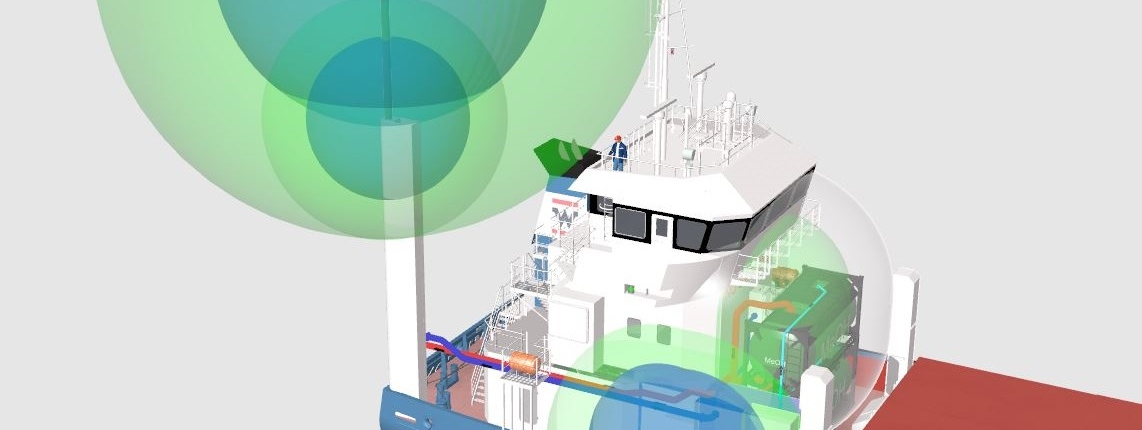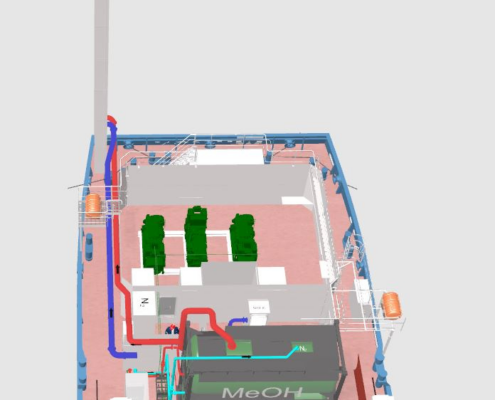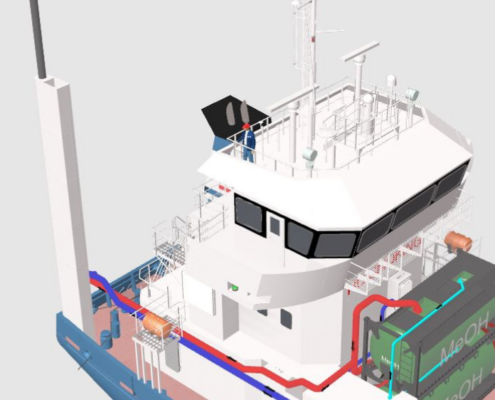From low to zero emission shipping with CIP-series
To reduce greenhouse gas emissions from shipping to zero by 2050, we need to ensure that we can use alternative fuels with zero or near-zero greenhouse gas emissions by 2030. The design of the CIP-series vessels provides the possibility of changing the type of fuel in the future without a radical conversion of the vessel. For a relatively small investment, you can convert your CIP-series vessel into a zero-emission vessel.
A carbon-neutral cycle is possible by replacing the diesel generators with a methanol power generator set and then installing methanol tanks, or taking the generator sets off completely, and installing tanks with liquid hydrogen and fuel cells. All these redesign possibilities were taken into account from the beginning of the conceptual design process of the CIP-series. In this article, we explain how it works to transform the CIP vessel’s fuel into green methanol propulsion and which considerations are good to take into account.
How to change the CIP standard vessel’s fuel into green methanol?
The design of the CIP-series vessels provides the possibility of changing the type of fuel in the future without a radical conversion of the vessel. One of the options is transforming the vessel’s fuel into green methanol. Compared to traditional fossil fuels, green methanol has significantly lower carbon emissions. When produced from biomass or waste materials, it recycles carbon that is already in the atmosphere, resulting in a carbon-neutral cycle.
Methanol has the advantage that it is relatively easy to handle and store because it is a liquid in a normal atmosphere. It is toxic and flammable, but these risks are largely mitigated in the design and if ever large quantities of methanol would spill into the sea, this has no long-term negative effects on nature. Due to the properties of methanol, methanol engines burn very cleanly and efficiently, so exhaust gases need no after-treatment.
“By converting the vessel to green methanol fuel, your vessel will maximize fuel efficiency and minimize environmental impact to almost zero.”
Julia Benedictus – Maritime Engineer at Conoship International.
The diesel generator sets can be replaced with methanol generator sets, and the diesel installation can be used for additives or emergency diesel by the flexible fuel engine. Methanol storage can be placed on an open deck in front of the wheelhouse, where also space is reserved for other methanol equipment that needs to be contained. None of these activities require significant structural work, which makes the refit straightforward.
How to ensure a consistent supply of green methanol for your green fleet?
Green methanol is produced from renewable sources such as biomass, carbon dioxide capture and utilization, or renewable hydrogen.
Green methanol can be a good alternative fuel for your fleet depending on the sailing route. As green methanol production is still limited available make sure it is available on your sailing route or explore establishing partnerships with renewable fuel producers. Good fuel delivery logistics, including port facilities and transport modes, are needed to ensure a consistent supply of green methanol.
An example of how green methanol can be created is by gasification of black liquor. This toxic byproduct is produced when wood is converted into wood pulp and then into paper. In comparison with other potential biomass sources for chemical production, black liquor has the great advantage that it is already partially processed and in a pumpable, liquid form. Using black liquor as a raw material for methanol production would have the following advantages:
- the process is easily pressurized;
- the syngas has a low methane content;
- gasification capital cost is shared between recovery of inorganic chemicals, steam production, and syngas production.
It will take time to establish the required production capacities, currently plans exist for Finland.
272 vessels are already methanol ready
In 2023 45% of all newbuild orders placed were alternative fuel capable, according to data Clarksons Research recently published. With an increase to 125 orders of methanol dual fuel vessels in 2023.
Steve Gordon, Global Head of Clarksons Research, commented:
“The largest share of alternative fuelled orders in 2023 was still LNG dual fuel (220 orders, of which 152 were non LNG Carriers), albeit with an increase to 125 orders of methanol dual fuel vessels in 2023. There were also 55 new orders involving LPG as a fuel and now 4 with Ammonia. Reflecting future “optionality”, there are 579 in fleet and newbuilds that have LNG “ready” status, 322 that are Ammonia “ready” and 272 that are Methanol “ready”.”
Why should you invest in a vessel of the CIP-series that easily can be transformed into green methanol propulsion?
In our previous article we explained several advantages to invest in our standard design of the CIP-series. The design of Conoship’s CIP-series is highly future-proof. Additional elements of the design arrangement facilitate a switch to future fuels, like methanol. Since 2021 methanol has attracted strong interest as an alternative marine fuel. The adoption of IMO’s interim guidelines for ships using methyl or ethyl alcohol as fuel (MSC.1/Circ.1621) has been an enabler for ship owners ordering ships that run on methanol.
“The CIP-series vessels are a good investment for the future to remain compliant with the IMO trajectory towards zero carbon. Methanol is a safe, proven, cost-competitive marine fuel for the commercial shipping industry that can meet or exceed current and planned emissions regulations.”
Maarten Sickler – Sales Director at Conoship International.
The capital investment for a vessel of the CIP-series is lower, because there is no need for pressurization or costly cryogenic fuel tanks and systems. The design of the CIP-series vessels provides the possibility of changing the type of fuel in the future without a radical conversion of the vessel. The replacement of the diesel generator sets with methanol generator sets requires no significant work, which makes the refit so straightforward.
If you choose a vessel from the CIP-series a successful transition to green methanol propulsion is ensured and your greenhouse gas emissions could be reduced to almost zero.
Need some advice? Contact us to discuss what fits best for you.







